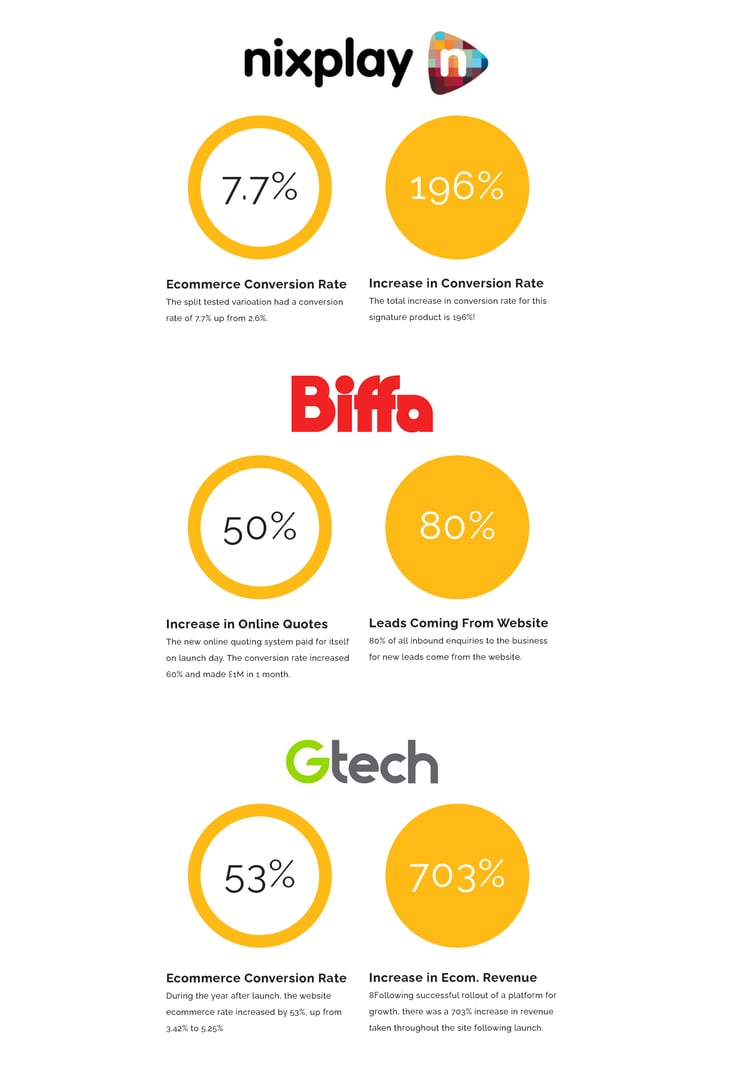How to track digital performance with thank you pages
What are thank you pages, and why are they important for monitoring performance? Find out more about thank you page best practices.
Read moreHeard the term CRO thrown about and not sure what it means? Cameron Hadley takes us through some commonly asked questions on conversion rate optimisation.
When I began my apprenticeship in digital marketing, I had very little idea of what CRO actually was. Being from a design background, I was excited to be joining ClickThrough’s web & UX team, but the world of conversion rate optimisation was completely new to me!
Luckily, I’m far from alone. As important a process as CRO is, many clients and in-house marketers are less familiar with the service than with things like PPC and SEO, so I was able to learn along with them. I quickly learnt how powerful a service CRO is for enhancing pages and ensuring marketing campaigns go further.
Looking back on my own questions that I had when I started, and the things clients often ask, I’ve put together a CRO FAQ. Whether or not you’ve used SEO or PPC to increase traffic to your website, here’s why you should cash in on every opportunity using CRO.
CRO, or Conversion Rate Optimization, aims to increase the number of users who perform a desired action on a website. These actions could be signing up to a service or subscription, purchasing a product, or filling out an enquiry form.
It’s tough to answer what makes a good conversion rate as each site will have different base lines in performance. When we decide on how to set your CRO goals, we take into account your current performance, the type of conversions you’re aiming for, and the types of products you’re selling.
If you’re diverting all your traffic to an unoptimized website where it’s difficult for a user to complete a sale or sign up for a service, however your visitors found you, you’ll still be left with pretty big bounce rates. A well optimised website will allow you to capitalise on that traffic.
Using CRO on your site and landing pages is an ideal way to compliment your existing marketing strategy. While PPC, SEO, and Paid Social are good ways to direct traffic to your site, CRO is what turns that into conversions. Beyond targeting relevant keywords, there are limits to how much influence these campaigns can have on conversions. CRO helps your entire marketing strategy achieve bigger, better results.
CRO is a type of web design, where we use data to inform all of our design decisions with the final goal of winning conversions. While standard web design will be based on the opinions of those involved in the project, CRO includes bug fixes and uses user testing to determine what will a) look good and b) make your visitors click in the right places!
Some aspects of CRO may not even strictly be down to web design. While we’ll present information the best way we can, we might sometimes make suggestions to our clients on what they can offer to improve conversions, whether that’s through shipping methods, competitive pricing, or product range.
Short answer – yes! As we covered above, CRO uses user data to make your site not only look good but provide a good experience for users. Our data comes from user testing, and the actionable feedback we get comes directly from people who have been using our test-sites. We use the data to design your site for humans.
Though CRO is a popular way of increasing sales, we can use conversion rate optimisation to improve conversions on anything that builds a relationship with a customer. This could be through sales, but it might also be newsletter sign ups, filling in enquiry forms, or signing up for subscription services. The short answer is – anyone who wants their site users to take a specific action on their site can use CRO to achieve this.
If the resource is available, I’d always recommend using CRO across your whole site to make sure conversions are watertight. If you’re working on a limited budget or resources, you can pinpoint which pages need CRO the most by looking at;
We use a variety of testing methods in CRO, including A/B Testing and user preference testing. In user preference testing, we provide offline users with different versions on the site and ask for feedback on how they found using each version. We ask for actionable feedback that we can use to make changes, and continue until we no longer have any suggestions come through.
Users need to be able to complete your desired action. Sometimes, this is easier said than done because of website bugs or poor UX design which can distract or in the worst cases, prevent users completing that action. Good CRO, achieved through bug fixes, UX design and testing, will see an increase in revenue and sales.
CRO aims to streamline the process of users landing on a web page to completing your desired action, therefore minimizing the risk of users exiting the site before they do anything.
This is an A/B test we ran at 50% in 2019 for a client. Our optimized web page saw an increased revenue of £21,076 over 3 weeks – £7,000 per week. If 100% of the traffic had been sent to the optimized page, this would have seen roughly a £14,000 increase per week.
For the same client, additional testing over the course of 6 months yielded revenue gains at 50% of traffic to winning variations of over £100k.
Through the CRO process, we’ve achieved results for a diverse range of clients. Here are some statistics proving just how essential CRO is to revenue growth:

At ClickThrough, we offer CRO retainers to clients so we can do continuous work on their sites to optimise for conversions. While you may think that a CRO project should be a standalone job, we believe that by offering the service on a retainer basis we can support our clients through events (such as Christmas & Black Friday), new product launches, and advertising campaigns.
We have a range of resources available for anyone wanting to learn more about CRO - whether they're a potential client or looking to grow their own skills and knowledge. You can view all our CRO blog posts in one easy place, or watch our free webinar replays to hear us cover the topic in more detail.
Want to talk to us about this amazing bit of marketing strategy? Get in touch to talk all things CRO!
More articles you might be interested in:

What are thank you pages, and why are they important for monitoring performance? Find out more about thank you page best practices.
Read more
Google sets new standards for links and content, new functionality emerges in Analytics and Search Console, and new tool Neurons hits the world of...
Read more
Welcome to the latest round-up of all things digital. This is where we look at the latest updates in the world of PPC, SEO, Content and International...
Read more.jpg)
Creating conversion-optimised PPC campaigns start at strategy planning. Do you know how you can maximise the return on your ad investment? Dave...
Read more.jpg)
Wondering how to apply conversion-centric marketing to your advertising strategies? Dr. Dave Chaffey explores why this is essential for growing...
Read more
Episode Six of The Assorted Digital Ramblings Podcast is now live! Learn about Conversion Rate Optimisation with guest Al.
Read more.jpg)
Are you using Data-led-Design to grow your brand? Dr. Dave Chaffey delves into what techniques you should be using to turn user data into intelligent...
Read more
CRO is the process of optimising your site or landing page towards conversions. Find out more about how to identify if your site needs the CRO...
Read more